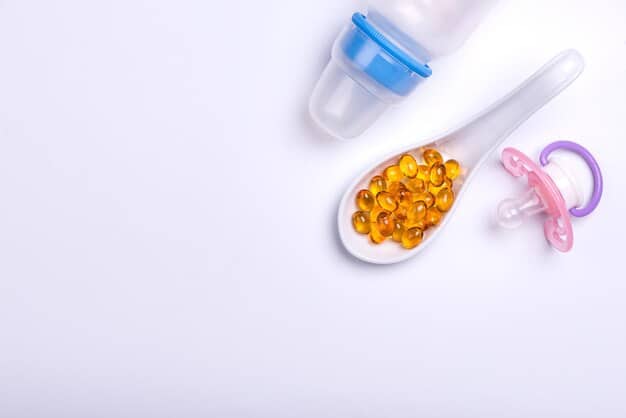Is Your Baby Getting Enough Vitamin D? Updated 2025 Guidelines

Ensuring your baby gets enough vitamin D is crucial for bone development and overall health; updated 2025 feeding guidelines offer insights into supplementation and dietary sources to meet their needs.
Navigating infant nutrition can be overwhelming, especially when it comes to essential nutrients like vitamin D. Are you sure you’re meeting your baby’s vitamin D requirements according to the latest 2025 guidelines?
Understanding Vitamin D and Its Importance for Babies
Vitamin D plays a critical role in your baby’s development. It helps the body absorb calcium and phosphorus, which are essential for building strong bones and teeth. A deficiency can lead to rickets, a condition that affects bone development in children.
Understanding the importance of vitamin D is the first step in ensuring your baby’s healthy growth. Let’s delve deeper into why this nutrient is so vital.
Why Vitamin D is Essential
Vitamin D isn’t just about strong bones; it’s also involved in immune function and cell growth. For babies, adequate vitamin D levels are especially crucial during their rapid growth phase.
Consequences of Vitamin D Deficiency
A lack of vitamin D can have serious consequences. Rickets, characterized by soft and weakened bones, is the most well-known. However, deficiency can also increase the risk of infections and other health issues.
- Ensures proper bone development.
- Supports a healthy immune system.
- Aids in calcium and phosphorus absorption.
Ensuring your baby receives enough vitamin D is a proactive step towards a healthier future. As parents, understanding these benefits and risks empowers us to make informed decisions.
In summary, vitamin D is essential for bone health, immune function, and overall development in babies. Deficiency can lead to serious health issues, highlighting the importance of meeting recommended levels.

Updated 2025 Feeding Guidelines for Vitamin D Intake
The American Academy of Pediatrics (AAP) and other health organizations have updated their guidelines for vitamin D intake in infants. These guidelines emphasize the importance of supplementation, especially for breastfed babies.
Staying informed about these updates is key to providing your child with the best possible care. Here’s what you need to know.
Recommended Daily Intake
According to the 2025 guidelines, all infants, regardless of feeding method, should receive a daily vitamin D supplement of 400 international units (IU) starting shortly after birth.
Breastfed vs. Formula-Fed Babies
Breast milk may not provide enough vitamin D, even if the mother is taking supplements. Therefore, breastfed babies need vitamin D drops. Formula-fed infants also need supplements if they are consuming less than 32 ounces of vitamin D-fortified formula per day.
- All infants need 400 IU of vitamin D daily.
- Breastfed babies require vitamin D drops.
- Formula-fed babies need supplements if intake is less than 32 ounces daily.
Following these guidelines ensures your baby’s vitamin D needs are met, regardless of their feeding method. Regular consultation with your pediatrician is also advisable.
In conclusion, the updated 2025 feeding guidelines stress the importance of vitamin D supplementation for all infants. Breastfed babies require daily drops, and formula-fed babies need supplements if their formula intake is insufficient.
Recognizing the Signs of Vitamin D Deficiency in Infants
Identifying vitamin D deficiency early can prevent serious health issues. Parents should be aware of the common signs and symptoms.
Early detection can make a significant difference in your child’s health. Here’s how to recognize the signs.
Common Symptoms to Watch For
Some common signs of vitamin D deficiency include delayed motor development, such as being slow to sit, crawl, or walk. Irritability, lethargy, and poor growth can also be indicators.
When to Consult a Pediatrician
If you notice any of these symptoms, it’s important to consult with your pediatrician. They can perform a blood test to check your baby’s vitamin D levels and recommend appropriate treatment.
- Delayed motor development.
- Irritability and lethargy.
- Poor growth.
Regular check-ups with your pediatrician are crucial for monitoring your baby’s health and addressing any potential deficiencies. Trust your instincts and seek professional advice when needed.
In summary, being vigilant about the signs of vitamin D deficiency, such as delayed motor development and poor growth, is crucial. Consult with your pediatrician if you have any concerns.

How to Choose the Right Vitamin D Supplement for Your Baby
Selecting the right vitamin D supplement can be confusing, with various products available on the market. Understanding what to look for will help you make an informed choice.
Choosing the right supplement ensures your baby receives the necessary nutrients safely and effectively. Here’s how to navigate the options.
Types of Vitamin D Supplements
Vitamin D supplements for babies typically come in liquid drop form. Look for products specifically designed for infants, as they will have the appropriate dosage and be free of harmful additives.
Dosage and Administration
Follow the dosage instructions on the product label or as recommended by your pediatrician. Administer the drops directly into your baby’s mouth or mix them with a small amount of breast milk or formula.
- Choose liquid drops designed for infants.
- Follow dosage instructions carefully.
- Administer drops directly or mix with milk or formula.
Consulting with your pediatrician before starting any supplement is always a good idea. They can provide personalized recommendations based on your baby’s specific needs.
In conclusion, when choosing a vitamin D supplement, opt for liquid drops designed for infants and follow dosage instructions carefully. Always consult with your pediatrician for personalized advice.
Dietary Sources of Vitamin D for Mom and Baby
While supplementation is often necessary, dietary sources of vitamin D can also play a role. For breastfeeding mothers, consuming foods rich in vitamin D can help improve their own levels, which indirectly benefits the baby.
Enhancing your diet with vitamin D-rich foods can complement supplementation efforts. Here’s what to consider.
Foods Rich in Vitamin D
Good sources of vitamin D include fatty fish (such as salmon and tuna), egg yolks, and fortified foods like milk and cereal. Breastfeeding mothers should include these foods in their diet.
Benefits of a Vitamin D-Rich Diet for Moms
A mother’s vitamin D levels can impact the amount of vitamin D in her breast milk. A diet rich in vitamin D helps ensure she provides the best possible nutrition for her baby.
- Fatty fish (salmon, tuna).
- Egg yolks.
- Fortified foods (milk, cereal).
While diet alone may not be sufficient to meet a baby’s vitamin D needs, it’s a valuable component of overall health and well-being for both mother and child.
In summary, incorporating vitamin D-rich foods into a breastfeeding mother’s diet can indirectly benefit the baby by improving the mother’s vitamin D levels. However, supplementation is still necessary for the baby to meet recommended intakes.
Vitamin D and Baby Formula: What You Need to Know
Many infant formulas are fortified with vitamin D, which can contribute to your baby’s daily intake. However, it’s important to understand how much vitamin D your chosen formula provides.
Understanding the vitamin D content in formula helps you determine if additional supplementation is needed. Here’s what to consider.
Vitamin D Content in Formula
Check the nutrition label on your baby’s formula to determine the amount of vitamin D per serving. Most formulas contain around 400 IU per liter, but this can vary.
Supplementation for Formula-Fed Babies
If your baby is consuming less than 32 ounces (approximately 1 liter) of vitamin D-fortified formula per day, they will still need a vitamin D supplement to reach the recommended 400 IU.
- Check the formula’s nutrition label for vitamin D content.
- Supplement if consuming less than 32 ounces daily.
- Monitor intake to ensure adequate vitamin D.
Regularly monitoring your baby’s formula intake ensures they receive an adequate amount of vitamin D. Adjust supplementation accordingly and consult with your pediatrician.
In conclusion, while many formulas are fortified with vitamin D, supplementation may still be necessary if your baby consumes less than 32 ounces per day. Regularly check the formula’s nutrition label and consult with your pediatrician.
Potential Risks of Over-Supplementation with Vitamin D
While vitamin D deficiency is a concern, it’s also important to avoid over-supplementation. Excessive vitamin D intake can lead to hypercalcemia, a condition characterized by high levels of calcium in the blood.
Understanding the potential risks of over-supplementation helps you maintain a safe and balanced approach. Here’s what to be aware of.
Symptoms of Vitamin D Toxicity
Symptoms of vitamin D toxicity include poor appetite, nausea, vomiting, and weakness. In severe cases, it can lead to kidney problems and other serious health issues.
Importance of Following Dosage Guidelines
Always follow the dosage instructions on the supplement label or as recommended by your pediatrician. Avoid giving your baby more than the recommended amount of vitamin D.
- Poor appetite, nausea, and vomiting.
- Weakness and fatigue.
- Potential kidney problems.
Monitor your baby for any signs of toxicity and consult with your pediatrician if you have any concerns. Adhering to recommended dosages is crucial for safe and effective supplementation.
In summary, while vitamin D is essential, over-supplementation can lead to toxicity. Follow dosage guidelines carefully and monitor your baby for any adverse symptoms.
| Key Point | Brief Description |
|---|---|
| 🌞 Daily Intake | All infants need 400 IU of vitamin D daily for bone health. |
| 🤱 Breastfeeding | Breastfed babies require vitamin D drops, regardless of mom’s intake. |
| 🍼 Formula Feeding | Supplement if intake is less than 32 oz of fortified formula/day. |
| ⚠️ Overdose Risks | Follow dosage guidelines to avoid vitamin D toxicity symptoms. |
Frequently Asked Questions (FAQ)
▼
Vitamin D is crucial for your baby’s health because it helps their body absorb calcium and phosphorus, both of which are essential for building strong bones and teeth. It also supports their immune system.
▼
According to the updated 2025 feeding guidelines, all infants, regardless of whether they are breastfed or formula-fed, should receive a daily vitamin D supplement of 400 international units (IU) starting shortly after birth.
▼
Common signs of vitamin D deficiency include delayed motor development (such as being slow to sit, crawl, or walk), irritability, lethargy, and poor growth. If you notice these, consult your pediatrician.
▼
Yes, it’s possible for your baby to get too much vitamin D. Over-supplementation can lead to vitamin D toxicity, which may cause symptoms like poor appetite, nausea, vomiting, and weakness. Follow dosage guidelines.
▼
Yes, breastfed babies should receive vitamin D supplements because breast milk may not provide enough vitamin D, even if the mother is taking supplements. Administer 400 IU of vitamin D daily.
Conclusion
Ensuring your baby gets enough vitamin D is a crucial aspect of their healthy development. By staying informed about the updated 2025 feeding guidelines, recognizing the signs of deficiency, and making informed decisions about supplementation, you can help your baby build a strong foundation for a healthy future.





